8 parade-worthy classic cars under $25,000
I love a parade, the tramping of feet,
I love every beat I hear of a drum.
I love a parade, when I hear a band
I just want to stand, and cheer as they come!
Say, that sounds like Harry Richman, a popular singer who was stuck loving parades in every show he did for the next two decades after I Love a Parade became a smash hit in 1932.
Know who else loves a parade? We do. Especially small-town ones, with classic cars following along behind the local police chief and some firemen on an old-time (red) fire truck with a Dalmatian (black and white).
When it comes to parade cars, the more varied they are, the better. Here are eight classics we’d love to see in a parade. Why, we’d stand and cheer as they came. Built before 1950, they’re all under $25,000, per Hagerty’s valuation experts. Prices are for number 3, or good, condition vehicles. (Want the full run-down on our 1-to-4 scale? Click here.)
1911 Ford Model T Open Runabout, $23,400
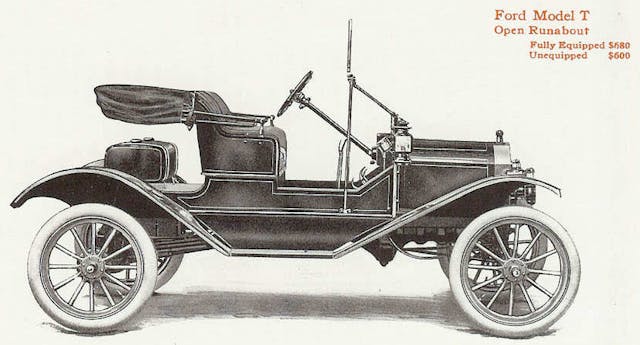
There’s nothing like the obligatory Model T, sold by Ford for 18 years with only basic changes. That said, 1911 saw mildly significant updates, with top, windshield, side curtains, and gas lamps for the convertible. “High-priced quality in a low-priced car,” Ford claimed. The standard color was Royal Blue, often with pinstripes (this was seven years before Henry Ford’s pronouncement that you could have any color you wanted, so long it was black). “Fully equipped,” said one ad from the times, for $680. Power is from the 20-horsepower four-cylinder engine. A T would be the perfect parade car for a high-school homecoming queen, who can do the cupped-hand “Princess Diana” wave from the right seat.
1947 Willys-Jeep CJ 2A, $13,600

Put the town’s oldest veteran in this Willys-Jeep CJ 2A, only a few years removed from the World War II era that spawned the military Jeep. There are only modest changes between that Willys-Jeep and this one. In fact, many out there are painted drab green in commemoration, with serial numbers stenciled on the hood, American flags flying from the front bumper.
CJ, of course, stood for “civilian Jeep,” a name that lasted from one manufacturer to another from 1945 until 1986, when it was replaced by the Jeep Wrangler in 1987. A total of 214,760 CJ-2As were produced, powered by the bulletproof 2.2-liter Willys Go-Devil engine.
1935 Auburn Supercharged sedan, $24,000
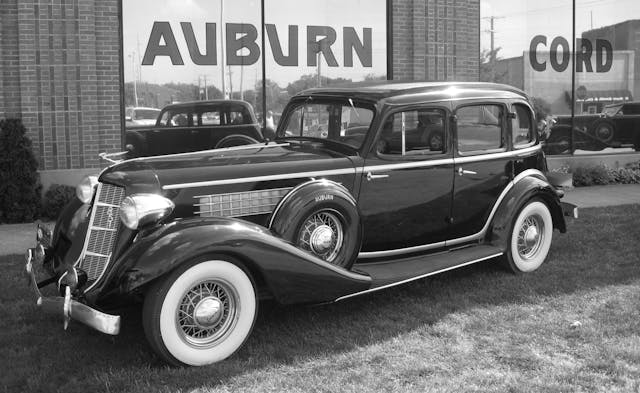
Yes, of course, Auburn is best known for its ultra-collectible 851 Supercharged Speedster, but that car blows our $25,000 price cap out of the water by about $767,000. That doesn’t mean the Supercharged Sedan isn’t a nice car. Plus, you can tell people you own a model that has some bits and pieces that sold for over $1 million, including the supercharged engine, which the Sedan was shared with the Speedster. The former still wears Auburn’s characteristically flowing mid-1930s sheetmetal, albeit without the boattail, and the elegant design should draw attention in any parade.
1946 Fiat Topolino, $22,100
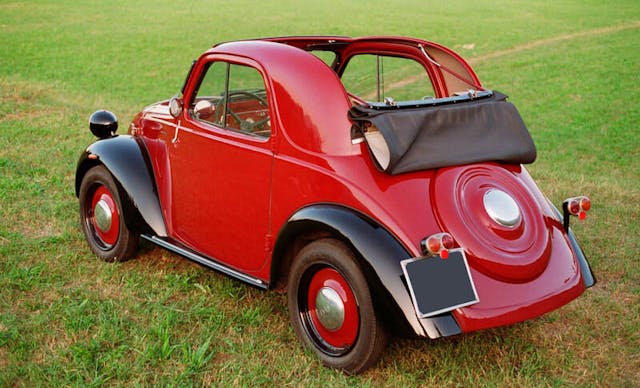
“Cute” cars always carry their weight in a parade, and they don’t come much cuter than the Topolino. With headlights that resemble mouse ears, it’s no wonder the Topolino has a name that translates to “little mouse” in Italian. Essentially a Fiat 500, the tiny Topolino looked and acted like a big car shrunk down, which is what many buyers wanted in the dawning era of the Volkswagen Beetle. Fiat recently resurrected the name for a teeny tiny, electric quadricycle; between the two, we’ll go old-school.
1927 Chrysler Series 60 roadster, $21,800
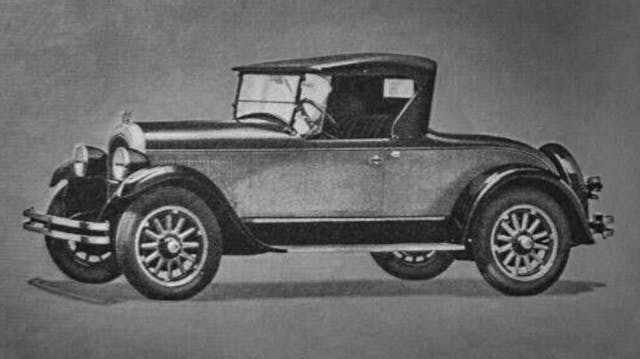
How about some relatively rare American iron? The Chrysler 60 Series debuted in 1927 as a roadster, sedan, landaulet, coupe, or touring car. We’ll take the 3.0-liter six-cylinder-powered roadster, because it gives local dignitaries proper visibility to wave at the crowd. As its name suggests, the car would exceed 60 mph–but hopefully not in a parade.
1948 Riley Roadster, $23,600
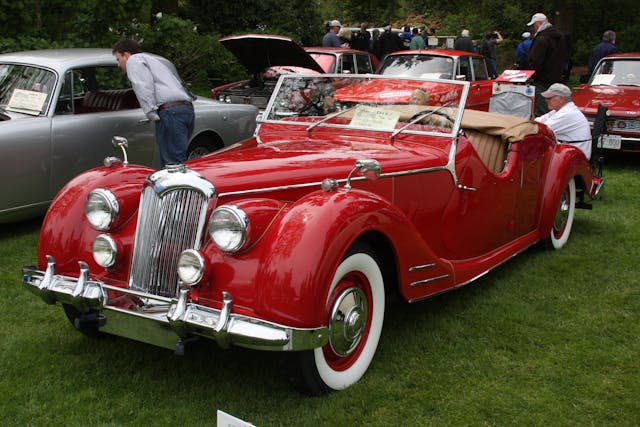
Perhaps just as rare as the 60 Series is the British 1948 Riley Roadster, a two-door, two- or three-seat convertible that’s unmistakably British. Sort of a cross between a sports car and a regular cabriolet, the Riley Roadster was targeted at the North American market. Powered by a 2.6-liter four-cylinder with a column-mounted shifter, it was capable of speeds up to 100 mph. Just over 500 were built before production ended in 1951.
1940 Chevrolet Model K Suburban, $24,900

The Suburban has been around serving roughly the same market segment since 1935. We’re picking the 1940 version, built during wartime, and the last model from Generation 1 (we’re up to 12 as of 2023). Power came from the venerable Stovebolt six-cylinder. There was seating for up to eight—three up front, two in the middle, three out back. After all, no parade is complete without clowns or a brass band, and they need transportation, too!
1949 Crosley Hot Shot, $14,800

Cute, part two. The cheerful-looking Crosley Hot Shot was the American equivalent of the MG- and Triumph-type roadsters that appealed to American soldiers serving in Europe during World War II. Back home, Powel Crosley, Jr. of the Crosley Radio Corporation and Crosley Motors, developed what is regarded as America’s first postwar sports car, the 1949 Crosley Hot Shot. It was powered, if you can call it that, by a 26-horsepower, 44-cubic-inch four-cylinder, but it was cheap at just $849. Only 2500 were built, but maybe you can find one to star in your hometown parade.
***
Check out the Hagerty Media homepage so you don’t miss a single story, or better yet, bookmark it. To get our best stories delivered right to your inbox, subscribe to our newsletters.
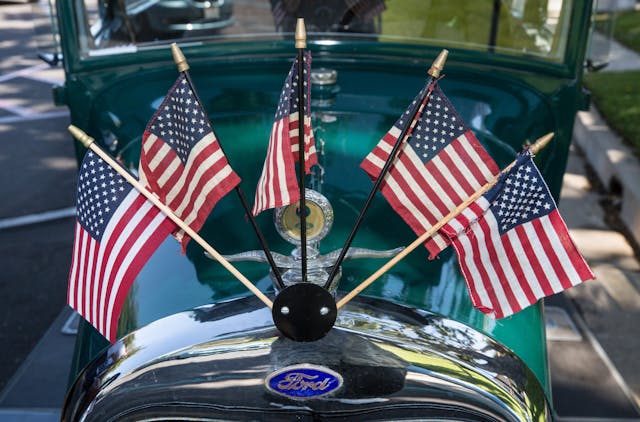


Freaky, I just bought a 1911 Runabout.
https://photos.app.goo.gl/QPqGsXHAupMGRP5a9
Wow, love the color! You need to find a parade…
I think it’s a one car parade whenever you see it!
👍
Beautiful!
OK, I just saw my new “want”! That Riley Roadster is way cool! Will fit right in with my MG, Mustang, & 2 Vettes!
If you are just displaying a car in a parade, then a sedan is fine. If you are displaying a person, a convertible is the way to go.
Slant six 70 Barracuda convertible “coupe” always a crowd pleaser white with blue interior. Smooth as silk and the beauty Queen can hear the claps of the crowd with no overheating issues !
The “Jeep” was first designed and built by the Butler Bantam Company in Butler, PA.
As the war was ending Popular Mechanics had a contest to see who could come up with the best idea to use the millions of Jeeps around. The winner was someone that proposed quite elaborate changes to the vehicle. A very good friend of mine, Neil Smith, was a teenager who won an honorable mention. His work was shockingly close to the way Jeeps ended up looking. The editors published his ideas and sent him a $100 check… quite a haul back then!
Surprised on how many sedans were on a parade list. Having said that I like the Auburn.
I thought the same thing. Whenever I see roundups for parade cars it always starts out with “Convertibles needed”.
You show a Model A on your article cover but then don’t list it. Less than $25,000 and common in parades!
And much easier to drive than a Model T. You can’t just throw the keys to someone and let them drive a T. It requires a training class and putting it in a parade without a very experienced operator would be risky. I know I just opened a can of worms her, so…
Besides being a great parade car, one of the best collector cars to start with. Many body styles, many prices and easy to work on.
Hi Joe and Will! I just sold my Model-A. I needed a cheat sheet for a long time to figure out how to start it, and end up with it running smoothly. I can’t imagine trying to start and drive a Model-T. Cheers!
Great job of picking, considering you only allowed yourselves eight. I appreciate you including the Crosley Hot Shot, it and its sibling Super Sport. They are so overlooked by the collector car market. I owned two, a sedan and station wagon, while in HS during the mid 50’s. From the factory, the Hot Shot did not have doors, only cutdown sides for access. The Super Sport came with doors that were full depth to the rockers. Ford V8 60’s with Nash rearends made popular transplants.
I am the current care taker of a 1950 CJ3A. I put 1500 to 2000 miles on it every year. I am proud to sat that every memorial day parade, I have one of our local Vets riding with me in honor of our country.
Just entered my 302 1969 Mustang convertible last month in a local town parade and it was a crowd favorite!
https://photos.app.goo.gl/fvhrKHWqVm7rRyVa8
very pretty! great parade car
If you want a genuine military Jeep (as opposed to a CJ) try a 1952-71 M38A1.
It spawned the CJ-5/6/7/8 and introduced the curved fender look.
A huge bonus is unlike the flat fenders, a if you are above 6′, you can actually fit in them.
All but the very nicest are well within your price limit.
Also, to make a convincing faux military Jeep it takes more than paint, most military Jeeps did not have tailgates plus there are a lot of other details. So, if you have a CJ leave it a CJ, especially very early postwar examples which have s column shift.
Later CJ-2/3s came in all sorts of great factory color combos, so you can amuse yourself by choosing one instead of “junking up” a CJ with all manner of military kitsch (like VW owners seem to do).
My M38A1 gets more positive comments than any other vehicle I own, including a George Barris TV car, besides, it is a lot of fun to drive.
I too have been a fan of the M38A1, never owned one but was in charge of one in my Army days in Hawaii in 1964. I was the company commanders jeep driver at the time and as with other officers rides it had been painted in gloss O.D. and the dashboard plaques were polished brass, I had to wax the thing and keep it as shiny as my boots were then. That Jeep was bullet proof as far as reliability goes, being 20 years old and already a hot rodder for life, as they say in the south, I beat that thing like a rented mule, drove it like I stole it when the Captain wasn’t aboard. It wasn’t exactly a parade vehicle but was shiny enough and would have qualified if called upon. It was also used in jungle warfare maneuvers a time or two, challenging my off road driving skills in mountain dirt roads made of super slick Hawaiian red clay and came through unscathed every time. I never burned out a clutch, or ruined a transmission or had it overheat, surprisingly considering all I put it through. Were I to consider an off road vehicle at my other place in the Sonoran Desert It would be my first choice. As a side note, at the time back then the U.S. Army had purchased another alternative to the Jeep, one made by Ford that had independent rear suspension, similar to that of say a, Triumph Spitfire of that era, that vaguely resembled a Mini Moke, but the suspension was problematic ant they easily flipped over without warning and several soldiers suffered greatly or worse and that Ford version was abandoned as a result. Would I like to find a nice affordable M38A1, yes please… Having 2 Vintage Mini Coopers as my car collection I of course would love to find an affordable Mini Moke as well, unfortunately it seems that ship has sailed…
You forgot my Mini Moke always a crowd pleaser .
Nice list. But why the CJ-2A? Great machine, along with the “Go Devil” engine, but why not the real thing, viz., a 1944 or 1945 MB. I loan mine to the local vets every year in our (rather small – on an island in Maine) 4th of July parade and it is always a hit.
Interesting list, but no serious vintage car owner would subject his car to two hours of nonstop idling, clutching and de-clutching.
No. Take your 50 Chevy and install a newer 350 auto trans and throw clutch away. Makes it very nice.
And enjoy a Frankencar. Too many without the knowledge to appreciate the real thing do this. So put an old body on a golf cart.
Don’t go to parades much, do you?
I see loads of them in parades. If the clutch is an issue, go for the Jeep: put it in first/low range, and you won’t declutch often.
Cheap and parade worthy? Look at 61-63 Rambler convertibles. I had a 63 two door sedan that a high school girl tried to talk her dad into buying for her, back around 2002. She said “it’s so ugly it’s cute”. Hmmm… left-handed compliment? But she was crazy about it. but a really cheap parade car would be a King Midget. Any year, but the squared sort of Jeep looking late 60s models are probably the best.
You totally missed Americas parade car. The Corvette Convertible.
Corvettes have for decades dominated parades and still are in great demand for parades and home coming game.
Prices on C3-4-5-6 can be found under your limit.
I just picked up my C5 for under that in prime condition and had my first parade in the NFL Hall Of Fame parade.
I got the honor to drive line backer Dave Robinson hall of famer for Green Bay Packers. Most all the players in the parade were in Corvettes. The starting point is as much a Corvette car show as parade.
You got that right! Corvette convertible.
As an example, I sold my 2008 LS3 Chevy Corvette convertible 2 years ago for 24.5k
Loaded 3LT, 35,000 mi, in mint condition– it would have interfaced very nicely with this list.
However, the writer chose to go toward the funky side of automotive nostalgia, his idea of keeping it edgy and interesting, with oddballs like the Fiat Figaro and the Crosley Hotshot.
the list the guys gave me stopped at 1949. maybe i need to do a 1950-on story!
WHAT! not one Cadillac, no Lincoln’s how about Chrysler Imperial, parades need floats!